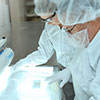Mass+Spectrometry
Catalog Number:
(77439-892)
Supplier:
Bioss
Description:
Heparin-binding epidermal growth factor-like growth factor (HB-EGF) is a 22kDa O-glycosylated protein that is a potent mitogen and chemoattractant for vascular smooth muscle cells, fibroblasts and epithelial cells but not endothelial cells. The natural protein has an apparent molecular mass of 19-23 kDa and exists in multiple forms as a result of heterogeneous O-glycosylation and/or Nterminal truncation. HB-EGF is synthesized as a membrane-anchored precursor(proHB-EGF) that is proteolytically cleaved to release the soluble mature growth factor. The two forms are active as juxtacrine and paracrine/autocrine growth factors respectively.HB-EGF activates two EGF receptor subtypes, HER1/ErbB1 and HER4 and binds to heparan sulfate proteoglycan.
Catalog Number:
(10095-354)
Supplier:
Proteintech
Description:
STS(Steroid sulfatase) is also named as ASC(arylsulfatase C), ARSC1 and belongs to the sulfatase family. It is expressed in human liver and is responsible for the hydrolysis of many estrogen and hydroxysteroid sulfates, including dehydroepiandrosterone (DHEA)-sulfate and β-estradiol(E2)-3-sulfate. This enzyme has also been documented to occur in many other tissues, including skin, lung, ovary, and adrenal gland. The estimated molecular mass of expressed human STS is 63-85 kDa which may represent different levels of glycosylation in the different tissues, as STS is known to be a glycoprotein and the full length protein has a signal peptide with 21 amino acids.
Supplier:
MilliporeSigma
Description:
SupraSolv® MS is dedicated for use in gas chromatography coupled with mass spectrometric detection. SupraSolv® solvents offer the largest specified retention time range, a clear baseline and a minimal signal-to-noise ratio leading to reliable and reproducible analysis results. This method is used e. g. for the analysis of dioxins and furans (PCDD/PCDF) in food and water samples or for the determination of PAH (polycyclic aromatic hydrocarbons) in food.
Supplier:
PeproTech, Inc.
Description:
OX40L, a member of the TNF superfamily of structurally related proteins, exists primarily as a type II membrane-bound, non-covalently linked, homotrimeric protein. It is expressed on antigen-presenting cells (APCs), such as dendritic cells and activated B-cells, as well as on various other cells such as vascular endothelial cells, mast cells, and natural killer cells. OX40L signals specifically through the OX40 receptor, which is expressed predominantly on CD4+ T cells, but also on certain activated CD8+ T cells. OX40/OX40L functions as a costimulatory signal, which is required for a productive interaction between antigen-presenting cells and their target T-cells. It enhances cell proliferation and survival, and increases expression of RANTES, IL-2, IL-3, and IFNγ. OX40/OX40L signaling plays an important role in immuno-regulatory communication, enabling the immune system to distinguish between “friend vs. foe” during activation; a mechanism typically termed immuno-tolerance. Recombinant Human sOX40 Ligand is a glycosylated 133 amino acid protein corresponding to the extracellular TNF homologous domain of the full length transmembrane protein. It migrates with an apparent molecular mass of 15.5 – 25.0 kDa on SDS-PAGE. Recombinant Human sOX40 Ligand has a calculated, theoretical molecular weight of 15.4 kDa.
Catalog Number:
(10089-096)
Supplier:
Proteintech
Description:
KLK5(Kallikrein-5) is also named as SCTE and belongs to the kallikrein subfamily. This protein is predicted to be a secreted serine protease, and the enzyme is found to have proteolytic activity. In serum and ascites fluid, the protein is present in two forms, one at a relatively lower molecular mass (around 50 kDa), and another one around 150-180 kDa and native KLK5 is highly glycosylated or that it may interact with the gel filtration column, leading to delayed retention. The activation of the enzyme has been shown to require cleavage of an arginine residue (Arg66-Ile67), suggesting that a trypsin-like serine protease may be involved in this process.
Catalog Number:
(89351-522)
Supplier:
Genetex
Description:
Kallikreins are a subgroup of serine proteases having diverse physiological functions. Growing evidence suggests that many kallikreins are implicated in carcinogenesis and some have potential as novel cancer and other disease biomarkers. This gene is one of the fifteen kallikrein subfamily members located in a cluster on chromosome 19. Its protein product is a protease present in seminal plasma. It is thought to function normally in the liquefaction of seminal coagulum, presumably by hydrolysis of the high molecular mass seminal vesicle protein. Serum level of this protein, called PSA in the clinical setting, is useful in the diagnosis and monitoring of prostatic carcinoma. Alternate splicing of this gene generates two transcript variants encoding different isoforms. Additional transcript variants have been described, but it is unclear if these transcripts are normally expressed or if they are specific to benign or malignant tumors.
Catalog Number:
(10085-672)
Supplier:
Proteintech
Description:
DARS2 is also named as AspRS (aspartyl-tRNA synthetase) and belongs to the class-II aminoacyl-tRNA synthetase family. The deduced 645-amino acid protein has a 47-amino acid mitochondrial targeting signal, resulting in a mature protein of 598 amino acids. DARS2 contains conserved residues involved in ATP binding, tRNA binding, and aspartic acid recognition, as well as catalytic site motifs characteristic of amino acid tRNA synthetases. It is a dimeric proteins. Rat aspartyl-tRNA synthetase has a N-terminal polypeptide extension of about 40 amino acid residues which can be removed without impairing its catalytic activity. This protein has different molecular mass(55 kDa, 50 kDa,66 kDa ) according to the publications.
Catalog Number:
(RL012-001-B32)
Supplier:
Rockland Immunochemical
Description:
Rat IL- 17A (IL-17), also known as CTLA-8, is a proinflammatory cytokine member of a six-species family of proteins (IL-17A-17F). Rat IL-17A protein is a homodimer consisting of two 134 amino acids peptides. IL-17A is secreted mainly by activated CD4+ and CD8+ T lymphocytes and acts through its receptor, IL-17R, to induce the expression of many mediators of inflammation, most strikingly, those that are involved in the proliferation, maturation and chemotaxis of neutrophils. Elevated levels of IL-17A have been associated with several conditions, including rheumatoid arthritis, airway inflammation, allograft rejection, inflammatory bowel disease, psoriasis, cancer and multiple sclerosis. There is 58% identity between the amino acid sequence of human and rat IL-17A. Recombinant rat IL-17A produced in E.coli is a non-glycosylated disulfide-joined homodimer having a molecular mass of 30.0 kDa.
Catalog Number:
(10086-874)
Supplier:
Proteintech
Description:
Fas (CD95/APO-1) is a transmembrane glycoprotein belonging to the tumor necrosis factor (TNF) receptor superfamily. It can mediates apoptosis by ligation with an agonistic anti-Fas antibody or Fas ligand. Stimulation of Fas results in the aggregation of its intracellular death domains, leading to the formation of the death-inducing signaling complex (DISC). FAS-mediated apoptosis may have a role in the induction of peripheral tolerance, in the antigen-stimulated suicide of mature T-cells, or both. The molecular mass of native Fas is 38 kDa, the high molecular weight form (40-55 kDa) of Fas is due to glycosylation.
Catalog Number:
(10092-802)
Supplier:
Proteintech
Description:
PRODH(Proline dehydrogenase 1, mitochondrial) is also named as PIG6, HSPOX2, PRODH1, PRODH2, POX, SCZD4, TP53I6 and belongs to the proline oxidase family. It is an oxidoreductase involved in the transfer of redox potential across the mitochondrial membrane and catalyzes the rate-limiting oxidation of proline to pyrroline- 5-carboxylate (P5C). High PRODH activity is sufficient to induce mitochondria-mediated apoptosis in the presence of proline. Defects in PRODH are the cause of hyperprolinemia type 1 (HP-1) and defects in PRODH are associated with susceptibility to schizophrenia type 4 (SCZD4). This protein has 3 isoforms produced by alternative splicing with the molecular mass of 68 kDa, 59 kDa and 56 kDa.
Catalog Number:
(10084-000)
Supplier:
Proteintech
Description:
Calpain 2(Calpain-2 catalytic subunit) is also named as CANPL2, CANPml, mCANP, FLJ39928 and belongs to the peptidase C2 family. N-terminal sequencing of CAPN2 purified from human liver indicates that the N-terminal methionine is removed, resulting in a mature 699-amino acid subunit with a calculated molecular mass of 79.9 kD. It is a calcium-regulated non-lysosomal thiol-protease which catalyzes limited proteolysis of substrates involved in cytoskeletal remodelling and signal transduction. It has 2 isoforms produced by alternative splicing with the molecular weight of 80 kDa and 71 kDa.
Catalog Number:
(10454-130)
Supplier:
Bioss
Description:
DRAK1 (DAP kinase-related apoptosis-inducing protein kinase 1) is a novel member of the ser/thr protein kinase family, which mediate apoptosis through their catalytic activities. The full-length cDNA encodes a deduced 414-amino acid protein with a molecular mass of 46.56 kD. DRAKs contain an N-terminal kinase domain and a C-terminal regulation domain. DRAK1 messenger RNA appears to be ubiquitously expressed in human tissues. Overexpression of DRAK1 induces apoptosis. It has been shown in vitro that DRAK1 is capable of autophosphorylation and of phosphorylating the myosin light chain as an exogenous substrate, and that the noncatalytic C terminus is crucial for full kinase activity.
Catalog Number:
(10454-346)
Supplier:
Bioss
Description:
DRAK1 (DAP kinase-related apoptosis-inducing protein kinase 1) is a novel member of the ser/thr protein kinase family, which mediate apoptosis through their catalytic activities. The full-length cDNA encodes a deduced 414-amino acid protein with a molecular mass of 46.56 kD. DRAKs contain an N-terminal kinase domain and a C-terminal regulation domain. DRAK1 messenger RNA appears to be ubiquitously expressed in human tissues. Overexpression of DRAK1 induces apoptosis. It has been shown in vitro that DRAK1 is capable of autophosphorylation and of phosphorylating the myosin light chain as an exogenous substrate, and that the noncatalytic C terminus is crucial for full kinase activity.
Catalog Number:
(10092-554)
Supplier:
Proteintech
Description:
POLDIP2(Polymerase delta-interacting protein 2) is also named as PDIP38, POLD4. It is as a unique positive regulator of Nox4 via its association with p22phox and together with Nox4, has profound effects on Rhodependent cytoskeletal remodeling. It is also as a regulator of cell division. It consists of 368 amino acids and has a predicted molecular mass of 42 kDa, with a potential signal peptide cleavage site after the first N-terminal 48 residues, which would result in a protein of 37 kDa. Endogenous human and rat POLDIP2 localized to the nucleus, plasma membrane, and cytoplasm.
Catalog Number:
(10085-498)
Supplier:
Proteintech
Description:
The human cytochrome P450c17 enzyme is encoded by the CYP17A1 gene. It is the qualitative regulator of steroidogenesis in the human adrenals.In its absence, aldosterone is produced in the human adrenal zona glomerulosa .The CYP17A1 gene is expressed in the adrenal cortex and the gonads but not in the placenta . Although CYP17A1 has been shown to be a 50-kDa protein, the presence of a lower molecular mass(30 kDa) immunoreactive form in rat Ley- dig cells was previously shown and it is either a degradation product or a truncated form of the 50 kDa enzyme. Defects in CYP17A1 are the cause of adrenal hyperplasia type 5 (AH5).
Catalog Number:
(76262-628)
Supplier:
Rockland Immunochemical
Description:
Anti-Leptin antibody detects leptin protein. Leptin may function as part of a signaling pathway that acts to regulate the size of the body fat depot. An increase in the level of LEP may act directly or indirectly on the CNS to inhibit food intake and/or regulate energy expenditure as part of a homeostatic mechanism to maintain constancy of the adipose mass. Obesity associated leptin is the product of the OB gene and has been identified with Type II diabetes. Anti-leptin Antibody is ideal for investigators involved in Cell Signaling, Obesity research, aging research and Signal Transduction research.
Inquire for Price
Stock for this item is limited, but may be available in a warehouse close to you. Please make sure that you are logged in to the site so that available stock can be displayed. If the
Stock for this item is limited, but may be available in a warehouse close to you. Please make sure that you are logged in to the site so that available stock can be displayed. If the
You must log in to order restricted items. We request that you provide the required business documentation to purchase this product for the first time.
To order chemicals, medical devices, or other restricted products please provide identification that includes your business name and shipping address via email CMD_NA@vwr.com or fax 484.881.5997 referencing your VWR account number . Acceptable forms of identification are:
-Additional Documentation May be needed to purchase this item. A VWR representative will contact you if needed.
This product has been blocked by your organization. Please contact your purchasing department for more information.
The original product is no longer available. The replacement shown is available.
This product is currently unavailable but limited stock may be available in our extended warehouse network. Please call 1-800-932-5000 and a VWR Customer Service Representative will help you.
|
|||||||||


































